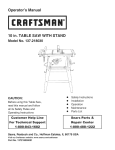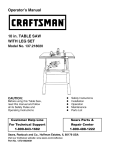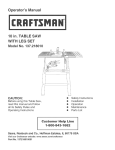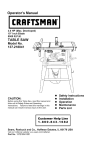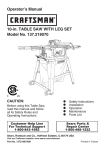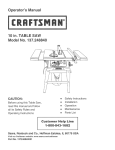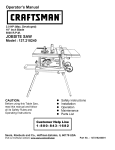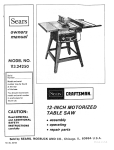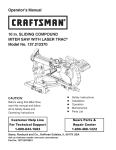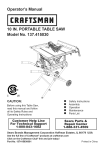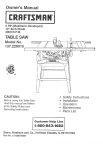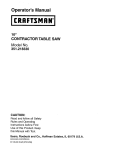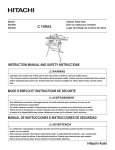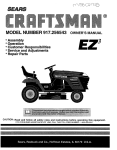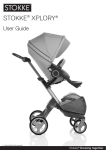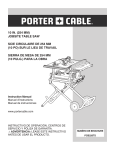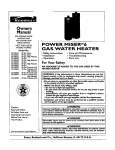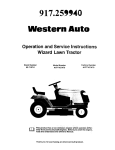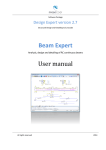Download Craftsman 137.24885 Saw User Manual
Transcript
Operator's Manual
®
10 in. TABLE SAW WiTH STAND
Model No. 137.248850
CAUTION:
Before using this Table Saw,
read this manual and follow
all its Safety Rules and
Operating instructions
Customer
Help
For Technical
Support
website:
Part No. 137248850001
o
e
Operation
Maintenance
•
Parts List
Repair
1-800,.843-1682
Visit our Craftsman
Safety Instructions
Installation
Sears
Line
Sears, Roebuck and Co., Hoffman
e
•
Parts
Center
1-800-488-1222
Estates,
www.sears.com/craftsman
IL 60179 USA
&
SECTION
PAGE
SECTION
PAGE
Warranty ................................................................
2
Know Your Table Saw ...................................
8
Product Specifications ...........................................
2
Glossary of Terms .........................................
9
Power Tool Safety .................................................
3
Assembly and Adjustments ...........................
10
Table Saw Safety ..................................................
4
Operation ......................................................
17
Electrical Requirements and Safety ......................
5
Maintenance .................................................
22
Accessories and Attachments ...............................
6
Tools Needed For Assembly .................................
Carton Contents ....................................................
6
6
Troubleshooting Guide ..................................
Parts List .......................................................
23
24
Push Stick Plan .............................................
28
ONE=YEAR
FULL WARRANTY
ON CRAFTSMAN
TOOL
if this Craftsman tool fails due to a defect in material or workmanship within one year from the date of purchase,
CALL 1 =800=4-MY-HOME® TO ARRANGE FOR FREE REPAIR (or replacement if repair proves impossible).
tf this tool is used for commercial or rental purposes, this warranty will apply for only ninety days from the date of
purchase. This warranty applies only while this tool is in the United States.
This warranty gives you specific legal rights, and you may also have other rights, which vary, from state to state.
Sears,
Roebuck
and Co., Hoffman
Estates,
IL 60179
WARNING
I
Some dust created by power sanding, sawing, grinding, drilling and other construction
activities contains
chemicals known to cause cancer, birth defects or other reproductive harm. Some examples of these
chemicals are:
•
Lead from lead-based paints
•
Crystalline silica from bricks, cement and other masonry products
•
Arsenic and chromium from chemically treated lumber
Your risk from these exposures varies, depending on how often you do this type of work. To reduce your
exposure to these chemicals,
dust masks that are specially
work in a well ventilated area and work with approved
designed to filter out microscopic
particles.
MOTOR
safety equipment
such as
SAW
Type ..........................................................
Universal
Amps .........................................................
Voltage ......................................................
Hz ..............................................................
15
120
60
RPM (no load) ...........................................
5000
Rip Capacity With Extension ........ 30 in. Right & 18 in. Left
Blade Size ................................... 10 in.
Blade Arbor Size ......................... 5/8 in.
Maximum
Maximum
Maximum
Maximum
Cut Depth @ 90° .........
Cut Depth @ 45 ° .........
Diameter Dado ...........
Dado Cut Width ..........
3 in.
2-1/2 in.
6 in. (Stackable only)
1/2 in.
[A WARNING
I
To avoid electrical hazards, fire hazards or damage to the tool, use proper circuit protection.
This tool is wired at the factory for 110=120 Volt operation. It must be connected to a 110=120 Volt / 15 Ampere
time delay fuse or circuit breaker. To avoid shock or fire, replace power cord immediately if it is worn, cut or
damaged in any way.
Before using your tool, it is critical that you read and understand these safety rules. Failure to follow these
rules could result in serious injury to you or damage to the tool.
GENERAL SAFETY iNSTRUCTiONS
Read and understand all the instructions below before using the power tool. These safety instructions are not
meant to cover every possible condition that could occur. As with any power tool, common sense, vigilance
and due care must be used.
1.
READ and become familiar with the entire Operator'
s Manual. LEARN the tool's application, limitations
and possible hazards.
17. NEVER LEAVE TOOL RUNNING UNATTENDED.
TURN THE POWER "OFF". Do not leave the tool
before it comes to a complete stop.
2.
[ _k WARNING
18. occur if the tool is tipped or if the cutting tool is
]Look for this symbol that
identifies important safety precautions, it means
CAUTION! Become alert, your safety is involved
if you do notfollow the safety instructions.
3.
4.
5.
[ _'
DANG ER _Look for this symbol that
identifies important safety precautions, it means
CAUTION! Become alert, your safety is involved
if you do not follow the safety instructions.
NEVER OPERATE THiS MACHINE WITHOUT
THE SAFETY GUARD iN PLACE FOR ALL
THROUGHSAWING OPERATIONS.
DO NOT USE iN A DANGEROUS ENVIRONMENT
such as damp or wet locations or exposure to rain.
Keep work area well lighted.
6.
DO NOT use power tools in the presence of
flammable liquids or gases.
7.
KEEP WORK AREA CLEAN. Cluttered areas and
benches invite accidents.
8.
KEEP CHILDREN AWAY. All visitors should be
kept at a safe distance from the work area.
9.
DO NOT FORCE THE TOOL. It will do the job
better and safer at the rate for which it was
designed.
10 USE THE RIGHT TOOL. Do not force the tool or
attachment to do a job for which it is not designed.
11. WEAR PROPER APPAREL. DO NOT wear loose
clothing, gloves, neckties, rings, bracelets or other
jewelry that may get caught in moving parts.
Nonslip footwear is recommended. Wear protective
hair covering to contain long hair.
12. WEAR A FACE MASK OR DUST MASK. Sawing,
cutting and sanding operations produce dust.
13. DISCONNECT TOOLS before servicing and when
changing accessories such as blades, cutters, etc.
14. REDUCE THE RiSK OF UNiNTENTiONAL
STARTING. Make sure the switch is in the OFF
position before plugging into the power supply.
15. USE ONLY RECOMMENDED ACCESSORIES.
Consult the Operator's Manual for recommended
accessories. The use of improper accessories may
cause injury to you or damage to the tool. adjusting
wrenches are removed from the tool before turning
ON.
16. REMOVE ADJUSTING KEYS AND WRENCHES.
Form the habit of checking to see that keys and
adjusting wrenches are removed from the tool
before turning ON.
NEVER STAND ON TOOL. Serious injury could
unintentionally
contacted.
19. DO NOT OVERREACH.
balance at all times.
Keep proper footing and
20. MAiNTAiN TOOLS WiTH CARE. Keep tools sharp
and clean for most efficient and safest performance.
Follow instructions for lubricating and changing
accessories.
21. CHECK FOR DAMAGED OR LOOSE PARTS.
Before further use of the tool, a guard or other
part that is damaged should be carefully checked
to ensure it will operate properly and perform its
intended function. Check for alignment of moving
parts, binding of moving parts, loose mounting
and any other conditions that may affect its safe
operation. A guard or other part that is loose or
damaged should be properly adjusted repaired or
replaced.
22. MAKE WORKSHOP CHILD PROOF with padlocks,
master switches or by removing starter keys.
23. DO NOT operate the tool if you are under the
influence of any drugs, alcohol or medication that
could impair your ability to use the tool safely.
24. USE A DUST COLLECTION SYSTEM wherever
possible. Dust generated from certain materials can
be hazardous to your health and in some cases, a
fire hazard. Always operate the power tool in a well
ventilated area with adequate dust removal.
25. ALWAYS WEAR EYE PROTECTION. Any power
tool can throw foreign objects into your eyes which
could cause permanent eye damage. ALWAYS
wear safety goggles (not glasses) that comply with
ANSI safety standard Z87.1. Everyday glasses
have only impact resistant lenses. They ARE NOT
safety glasses. NOTE: Glasses or goggles not in
compliance with ANSI Z87.1 could cause serious
injury when they break.
26. DiRECTiON OF FEED. Feed work into a blade or
cutter against the direction of rotation of the blade or
cutter only.
27. DO NOT AUTHORZE ADDiTiONAL USERS to
operate this power tool without the accompanying
operators manual for which the user must read and
understand.
ALWAYS USE SAW BLADE GUARD, splitter
and anti-kickback pawls for every through-sawing
operation. Through-sawing operations are those
in which the blade cuts completely through the
workpiece when ripping or crosscutting. Always be
sure blade guard is tightened securely.
2.
3.
4.
and the sides of the saw table for long or wide
workpieces.
13. AVOID KICKBACKS (work thrown back towards
you) by keeping the blade sharp, the rip fence
parallel to the saw blade and by keeping the splitter,
ALWAYS HOLD WORK FIRMLY against the miter
gauge or rip fence.
anti-kickback pawls and guards in place, aligned
and functioning. Do not release work before passing
it completely beyond the saw blade. Do not rip work
ALWAYS USE a push stick, especially when ripping
narrow stock. Refer to ripping instructions in this
Operator's Manual where the push stick is covered
in detail. A pattern for making your own push stick is
included on page 28.
that is twisted, warped or does not have a straight
edge to guide it along the fence. Do not attempt to
reverse out of a cut with the blade running.
NEVER PERFORM ANY OPERATION
FREEHAND, which means using only your hands
to support or guide the workpiece. Always use
either the fence or the miter gauge to position
and guide the work,
I,_k DANGER]
FREEHAND CUTTING iS THE MAJOR CAUSE OF
KICKBACK AND FINGER/HAND AMPUTATIONS,
NEVER USE THE MITER GAUGE AND FENCE
SIMULTANEOUSLY,
5.
12. PROVIDE ADEQUATE SUPPORT to the rear
NEVER STAND or have any part of your body in
line with the path of the saw blade. Keep your hands
out of the saw blade path.
14. AVOID AWKWARD
OPERATIONS
and hand
positions where a sudden slip could cause your
hand to move into the saw blade.
15. NEVER USE SOLVENTS to clean plastic parts.
Solvents could possibly dissolve or otherwise
damage the material. Only a soft damp cloth should
be used to clean plastic parts.
16. MOUNT your table saw on a bench or stand
before performing any cutting operations. Refer to
ASSEMBLY on page 10.
17. NEVER CUT METALS or materials that may make
hazardous dust.
18. ALWAYS USE IN A WELL=VENTILATED
6.
NEVER REACH behind or over the cutting tool for
any reason.
7.
REMOVE the rip fence when crosscutting.
8.
DO NOT USE a molding head with this saw.
9.
FEED WORK INTO THE BLADE against the
direction of rotation only.
AREA.
Remove sawdust frequently. Clean out sawdust
from the interior of the saw to prevent a potential fire
hazard.
19. NEVER LEAVE THE SAW RUNNING
UNATTENDED. Do not leave the saw until the
blade comes to a complete stop.
10. NEVER use the rip fence as a cut-off gauge when
crosscutting.
20. FOR PROPER OPERATION follow the instructions
in this Operator's Manual entitled OPERATION
(Page 17).
NOTE: On machines with no stand or if stand is not
11. NEVER ATTEMPT TO FREE A STALLED SAW
BLADE without first turning the saw OFF. Turn
power switch OFF immediately to prevent motor
damage.
being used, a hole approximately 11 in. square must
be cut under saw to allow sawdust to fall through.
Failure to cut this hole will allow sawdust to build
up in the motor area, resulting in a fire hazard and
potential motor damage.
GROUNDING
iNSTRUCTiONS
IN THE EVENT OF A MALFUNCTION OR
BREAKDOWN, grounding provides a path of least
resistance for electric currents and reduces the risk of
electric shock. This tool is equipped with an electrical
cord that has an equipment-grounding conductor
and a grounding plug. The plug must be plugged
into a matching receptacle that is properly installed
and grounded in accordance with all local codes and
ordinances.
DO NOT MODIFY THE PLUG PROVIDED. tf it will not
fit the receptacle, have the proper receptacle installed
by a qualified electrician.
IMPROPER CONNECTION of the equipment grounding
conductor can result in risk of electric shock. The
conductor with the green insulation (with or without
yellow stripes) is the equipment grounding conductor.
tf repair or replacement of the electrical cord or plug is
necessary, do not connect the equipment grounding
conductor to a live terminal.
CHECK with a qualified electrician or service person
if you do not completely understand the grounding
instructions, or if you are not certain the tool is properly
grounded.
or a #14 wire with a 15 A time-lag fuse. NOTE: When
using an extension cord on a circuit with a #14 wire, the
extension cord must not exceed 25 feet in length. Before
connecting the motor to the power line, make sure the
switch is in the off position and the electric current is
rated the same as the current stamped on the motor
nameplate. Running at a lower voltage will damage the
motor. This tool is intended for use on a circuit that has
a receptacle like the one illustrated in Fig. 1.
Fig. 1 shows a three-pronged electrical plug and
receptacle that has a grounding conductor. If a properly
grounded receptacle is not available, an adapter (Fig. 2)
can be used to temporarily connect this plug to a twocontact grounded receptacle. The adapter (Fig. 2) has a
rigid lug extending from it that MUST be connected to a
permanent earth ground, such as a properly grounded
receptacle box.
CAUTION
In all cases, make certain the receptacle is properly
grounded, if you are not sure, have a qualified
electrician check the receptacle.
CAUTION
This tool is for indoor use only. Do not expose to
rain or use in damp locations.
Fig. 1
Three-Pronged Plug
USE only three-wire extension cords that have threepronged grounding plugs with three-pole receptacles
that accept the tool's plug. Repair or replace damaged
or worn cords immediately.
q7
_1_1
{__..)
GUIDELINES
FOR EXTENSION
CORDS
USE THE PROPER EXTENSION CORD. Make sure
your extension cord is in good condition. Use an
extension cord heavy enough to carry the current your
product will draw. An undersized cord will cause a drop
in line voltage resulting in loss of power,
overheating and burning out of the motor. The table on
the right shows the correct size to use depending on
cord length and nameplate ampere rating, tf in doubt,
use the next heavier gauge. The smaller the gauge
number, the heavier the cord.
Make sure your extension cord is properly wired and in
good condition. Always replace a damaged extension
cord or have it repaired by a qualified technician before
using it. Protect your extension cords from sharp
objects, excessive heat and damp or wet areas.
Use a separate electrical circuit for your tool. This circuit
must not be less than #12 wire with a 20 A time-lag fuse
Properly Grounded
g Prong
Three-Pronged Receptacle
Grounding Lug _-#......
Fig. 2
/ I_!
Make sure this is
I_ ._-_
connected to a
_[ _.._,_I known ground.
_,
_
_
Two-Pronged
_.L_
_}4_
J
Adapter -'-_
Receptacle
CAUTION
This tool must be grounded while in use to protect
the operator from electric shock.
'
O"
•
O'm
'
(When using 120 volts only)
Ampere Rating
Total length of Cord
MoreThan
Not MoreThan 25ft. 50ft. 100ft. 150ft.
0
6
8
16
16
14
6
10
10
12
8
6
I6
16
14
14
12
12
RECOMMENDED
ACCESSORIES
WARNING
I
Visit your Sears Hardware Department or see the
Craftsman Power and Hand Tools Catalog to purchase
recommended accessories for this power tool.
Separate all parts from packing materials. Check each
part with the illustration on the next page and the "Table
of Loose Parts" to make certain all items are accounted
for, before discarding any packing material.
[A WARNING
I
IA WARNING
I
To avoid the risk of personal injury:
• Do not use adjustable (wobble) type dadoes or
carbide tipped dado blades.
= Only use atackable dadoes.
• Maximum dado width is 1/2".
if any part is missing or damaged, do not attempt
to assemble the table saw, plug in the power cord,
or turn the switch ON until the missing or damaged
•
•
•
Do
Do
Do
not
not use a dado with a diameter larger than 6".
not use molding head set with this saw.
not modify this power tool or use accessories
recommended
by Sears.
SUPPLIED
Blade wrench
NOT SUPPLIED
Medium screwdriver
#2 Phillips screwdriver
Blade wrench
[ II
II
II
III
II
Straight edge
3 mm Hex key
I
pert is obtained and is installed correctly. To avoid
electric shock, use only identical replacement
parts when servicing double insulated tools. Call
1=800=4-MY=HOME® for replacement parts.
TABLE
OF LOOSE
PARTS
ITEM
A
B
C
DESCRIPTION
Table saw assembly
Rear table extension
Rear table extension tube
QUANTITY
1
1
2
D
E
F
G
H
Hardware bag assembly
Blade guard and splitter assembly
Hardware bag assembly
Handwheel
Dome nut
1
1
1 each
2
2
t
J
K
L
Rip fence
Hex key
Blade
Blade wrench
1
1
1
2
M
N
O
P
Right extension wing table
Miter gauge
Hardware bag assembly
Left table extension
1
1
1
1
Q
R
Upper tube
Dust bag
2
1
Floor plate
Stand door
Stand base
1
1
1
STAND
Adjustable wrench
S
T
U
NOTE: To make assembly easier, keep contents of box
Combination square
together. Apply a coat of automobile wax to the table.
Wipe all parts thoroughly with a clean dry cloth. This will
reduce friction when pushing the workpeice. To avoid
injury, the styrofoam block should be removed between
the motor and table.
UNPACKING
YOUR TABLE
SAW
l ....
B
A
C
J,Jl_
D
\
J
K
N
R
L
0
P
T
M
1
Bladeguard
MitergaugeX
Extension
winglockinglever
Bladetiltscale
Bladetiltpointer
Overloadresetswitch
ON/OFFswitchwithsafetykey
Ripfenceandmiter
gaugestorage
Tableinsert
fence
Sidetableextension
wing
Beveltiltinghandwheel
Bladebevellockknob
Bladeelevationhandwheel
Toolsstorage
ANTFKICKBACK
PAWLS- Prevents
theworkpiece
frombeingkickedupwardor backtowardthefrontof the
tablesawbythespinningblade.
OVERLOAD
RESETSWITCH
- Resetsthe
thermocouple
andprovidesa wayto restartthesaw
motorif it overloads
oroverheats.
ARBOR- Theshaftonwhichthebladeordadois
mounted.
PUSHSTICK- Usedtopushworkpieces
when
performing
rippingoperations.
BEVELCUT- Ananglecutmadethroughthefaceof
theworkpiece.
RESIN- A stickysapthathashardened.
BLADEBEVELSCALE- Measures
theangletheblade
is tiltedwhensetfora bevelcut.
BLADEELEVATION
HANDWHEEL
- Raisesand
lowerstheblade.
BLADEGUARD- Clearplasticcoverthatpositions
itselfoverthebladewhilecutting.
COMPOUND
CUT- Asimultaneous
bevelandmiter
cut.
CROSSCUT - A cut made across the width of the
workpiece.
DADO - Special cutting blades that are used to cut
grooves in a workpiece.
FREEHAND - Performing a cut without using a rip
fence, miter gauge, hold down or other proper device to
prevent the workpiece from twisting during the cutting
operation.
GUM - A sticky sap from wood products.
HEEL - Misalignment of the blade.
REVOLUTIONS
PERMINUTE(RPM)- Thenumberof
turnscompleted
bya spinningobjectinoneminute.
RiPFENCE- A guideusedforripcuttingwhichallows
theworkpiece
tocutstraight.
RiPPiNG-
Cutting with the grain of the wood or along
the length of the workpiece.
SAW BLADE PATH - The area of the workpiece or
table top directly in line with the travel of the blade or the
part of the workpiece that will be cut.
SET - The distance between two saw blade tips, bent
outward in opposite directions to each other. The further
apart the tips are, the greater the set.
SPLITTER - Keeps the workpiece split apart after being
cut to prevent binding on the blade and workpiece.
TABLE iNSERT - Insert that is removed from the table
to install / remove blades, tt is also removed for dado
cutting. When dado cutting, a dado insert plate must be
used.
THROUGH SAWING - Making a cut completely
through the length or width of a workpiece.
WORKPIECE - Material to be cut.
JAMB NUT - Nut used to lock another nut in place on a
threaded rod or bolt.
Leading edge
KERF - The amount of material removed by the blade
cut.
Saw blade path
Kerf
Surface
MITER CUT - An angle cut made across the width of
the workpiece.
Trailing edge
MITER GAUGE - A guide used for crosscutting
operations that slides in the table top channels (grooves)
located on either side of the blade, it helps make
accurate straight or angle crosscuts.
Workpiece
ASSEMBUNG
STAND(FIG.A)
1. Unpackallpartsandgroupbytypeandsize.Refer
tothepartslistforcorrectquantities.
2. Attachthestanddoor(3)tothefrontofthestand
base(5)usingthreescrewsM5"12-12(4).
3. Attachthefloorplate(1)tothestand(5)using
tenscrewsM5"12-12(2).SeePARTSLISTAND
SCHEMATIC
FORSTANDSECTION.
NOTE:A shelf(notincluded) canbeaddedtothe
standbase(seenextsectionpriorto installingthe
floorplate(1)).
4. Tightenhardware.
5. Placethestandona levelsurfaceandadjustthe
rear-leftadjustable
foot,sothestandis contacting
thefloor.
INSTALUNG
A SHELF (NOT iNCLUDED)
(FIG. A-2)
NOTE: Attach shelf before assembling the floor plate.
1. Turn the stand upside down.
2. Rest the shelf board against the 4 shelf support fins
located on the side of the cabinet.
3.
Drill 4 apporpiately sized holes, two on each side,
through the cabinet into the shelf endgrain.
4.
Secure the shelf with four wood screws (not
included).
Tighten the four wood screws.
5.
Fig. A-2
1
Fig.A
ASSEMBLE TABLE SAW TO STAND (FIG. B)
1.
2.
3.
Place the saw (6) on the stand (5).
Line up the four holes in saw base and stand (5).
Fasten saw to stand using four hex bolts (7).
4.
Tighten all four hex bolts (7).
NOTE: DO NOT OVER TIGHTEN. THiS MAY
DAMAGE THE SAW BASE.
I ,WARNING
I
IF THE STAND WILL NOT BE USED, DO NOT
OPERATE THE TABLE SAW ON THE FLOOR. THiS
IS A VERY DANGEROUS POSiTiON.
Fig. B
SHELF CONSTRUCTION (FIG. A-l)
•
Use good quality plywood or solid wood
•
The shelf must be installed before the floor plate (1)
(Fig. A).
Fig. A-1
p,
22-1/2 in
,_
J
83" /
,I3/4
t
MOUNTSAWONWORKSURFACE
1. tf thestandwillnotbeused,thesawmustbe
properlysecuredtoa sturdyworkbench
usingthe
fourmountingholesat thebaseofthesaw.
2. Squarethesawonthe mounting
surfaceandmark
thelocationofthefour3/8in.mountingholes.
3. Drillthefour3/8in.holesintothe mounting
surface.
4. Placethesawontheworksurface,andalignthe
mounting
holesofthesawwiththosedrilledthrough
thesurface.
5. Fastenthesawtotheworksurface.Usinghardware
suchas 1/2in.lugboltswithwasher.
RIP FENCE (FIG. D)
1. Lift upward on the rip fence handle (1) so the rear
holding clamp (2) is fully extended.
2. Place the rip fence on the saw table, and attach the
set plate (3) under the fence handle (1) to the rail
first.
3. Push down on the fence handle (1) to lock.
Fig. D
[A WAR"ING
1
Do not operate this machine on the floor. This is
very dangerous and may cause serious injury.
[A WARNING
I
Always keep your work area clean, uncluttered and
well lit.
INSTALLING
BLADE RAISING HANDWHEEL (FIG. C)
1. Attach the up - down handwheel (1) to the elevation
AND CHANGING THE BLADE
(FIG. E, F, G)
I,_
rod (2) at the front of the saw. Make sure the slots (3)
in the hub of the handwheel (1) engage with the pins
(4).
2. Attach and tighten the dome nut (5 - Fig. C-1).
WARNING
I
* To avoid injury from an accidental start, make
sure the switch is in the OFF position and the
plug is not connected to the power source outlet.
,, To avoid serious injury, the rear of the table insert
must be level with the table. To adjust rear of
table insert, adjust the screw (3) in or out until
the rear of the insert is level to or slightly above
the table. To raise the insert, turn the screw
counterclockwise, to lower the insert, turn the
screw clockwise. NOTE: A rubber adjusting
spacer (4) is provided under rear of insert for this
purpose.
Fig. C
1
1.
BLADE TILTING HANDWHEEL (FIG. C=f)
1. Attach the bevel 0 ° - 45 ° handwheel (6) to the blade
tilting rod on the right side of the saw in the same
manner as above.
2. Attach and tighten the handwheel dome nut (5).
Remove the table insert (1) by removing the two
screws (2, 3). Be careful not to lose the rubber
adjusting spacer (4) that is on the back screw (3)
beneath the table insert (Fig. E).
Fig. E
Fig. C=1
_
{
_======t
_3
8---2
//
11
2. Raisethebladearbor(4-Fig.F)tothemaximum
heightbyturningthebladeraisinghandwheel
counterclockwise.
3. Placetheopen-endwrench(8)jawsontheflatsof
thesawarborto keepthearborfromturning(Fig.G)
andplacethebox-endwrench(9)on thearbornut
(5),andturncounterclockwise.
4. Removethearbornut(5)andouterflange(6-Fig.F).
5. InstallthesawbladeontothearborwiththeBLADE
TEETHPOINTING
TOWARDTHEFRONTOFTHE
SAW.
6. Installtheflange(6)againstthebladeandthreadthe
arbornut(5)asfaras possibleby hand.Ensurethat
thebladeis flushagainsttheinnersideof theblade
flange.
IA WARNING
!
To avoid injury from a thrown workpiece, blade
parts, or blade contact, never operate saw without
the proper insert in place. Use the original installed
insert for all through=sawing
operations except dado
cuts. A special dado insert plate must be installed
when using a dado blade.
BLADE GUARD ASSEMBLY (FIG. H, I, J)
1. Set the blade to maximum height and the tilt to zero
degrees on the bevel scale with the hand wheels.
Lock the blade bevel lock knob.
2. Place the spring washer (2), flat washer (3), external
tooth lock washer (4) onto the blade guard mounting
bolt (1) (Fig. H).
3. Insert bolt and washer assembly through splitter
bracket (5).
[A WARNING
I
To avoid possible injury and damage to the
workpiece, be sure to iNSTALL THE BLADE WiTH
THE TEETH POiNTiNG TOWARD THE FRONT OF
TABLE in the direction of the rotation arrow on the
Fig. H
blade guard.
5
J
Fig. F
4 7
Blade guard
6
5
4
_
1
and splitter ass'y
12
7. To tighten the arbor nut, (5) place the open-end
wrench (8) on the flats of the saw arbor to keep the
arbor from turning (Fig. G).
8. Place the box-end wrench (9) on the arbor nut (5),
and turn clockwise (to the rear of the saw table).
9. Replace the blade insert in the table recess, insert
the screws through the front and rear holes and
tighten remembering the rubber adjusting spacer
(4-Fig. E) under the rear of the insert and leveling the
rear of the insert to the table.
4. Install the blade guard and splitter assembly (6) into
the rear of the saw table. Thread the bolt (1-Fig. H)
into the internally threaded pivot rod (7) until snug.
Fig. I
Fig. G
8
--
5. Lift blade guard arm (8) up and using a straight
edge, align the blade guard and splitter ass'y (9) with
the saw blade (10) (Fig. J).
6. Shift the splitter bracket assembly to right or left until
parallel alignment to the blade is achieved.
12
7. Whenthesplitteris properlyalignedwiththesaw
blade,tightentheboltsecurely.
NOTE:The splitter bracket must always be
INSTALLING TABLE SIDE EXTENSIONS (FIG. L, L=I)
1. Identify the right hand table extension.
NOTE: For illustration purposes the view in Fig. L
looks "through" the saw table to the under side of the
table. The right hand table extension is the one with
the measuring scale visible from the front of the saw
when it is installed to the right hand side of the saw
table.
2. Unlock both front and rear cam locking levers (4) on
the right hand side of the saw base by flipping the
lever over.
3. Insert the table extension mounting tubes (2) into the
two matching holes in the cam lever assemblies.
NOTE: Make sure the front mounting tube has the
measuring scale visible from the front of the saw.
4. Slide the table extension toward the table until it rests
against the saw table.
5. Lock both cam locking levers by pushing them in
toward the cam locking lever assemblies.
6. tf the extension is not level to the table, adjust by
inserting the spacers (Carton Contents D) between
the extension and the tube it mounts onto. See page 17.
7. Make sure the screw (1) into the matching hole (2)
of the extension mounting tube (3).
8. Install the left hand table extension the same manner
NOTE:
• Make sure the screw (1) into the matching hole (2)
of the extension mounting tube (3) (Fig. L-1 ).
• For illustration purposes, the view in Fig. L looks
"through" the saw table to the under side of the table.
correctly aligned so the cut workpiece will pass
on either side without binding or twisting,
[A WARNINa
I
See Fig. I-1 flat washer (11) must be under knob
(12). NOTE: Be sure to tighten knob very tight and
periodically check tightness.
Fig, I-1
AVOID KICKBACKS (FIG. J)
(Work thrown back towards you) by keeping the blade
sharp, the rip fence parallel to the saw blade and by
keeping the splitter, anti-kickback pawls and guards
in place, aligned and functioning. Do not release work
before passing it completely beyond the saw blade. Do
not rip work that is twisted, warped or does not have a
straight edge to guide it along the fence. Do not attempt
to reverse out of a cut with the blade running.
[,A
WARNING
I
Improper splitter alignment
and serious injury.
Fig, J
Anti-kickback
Pawl
can cause "kickback"
Fig, L
8
10
INSTALLING RIGHTSIDE TABLE EXTENSION WING
(FIG. K)
1. Insert the two extension mounting tubes (3) into the
side table extension wing (2).
NOTE: Make sure the front mounting tube has the
measuring scale visible from the front of the saw.
2. Insert the screws (1) through the mounting tubes (3)
into the side table extension wing (2).
3. Tighten the screws (1).
Fig. K
z_
2 \
1
Fig. L=I
2
3
13
4
3
5. tf fence is loose when the handle is in the locked
INSTALLING REAR TABLE EXTENSION (FIG, M)
1. Place the rear table extension onto the two rear table
(downward) position, do the following:
extension tubes (1).
2. Snap two long location seats (2) over the two rear
= Move the handle (2) upward and turn the adjusting
nut (5) clockwise until the rear clamp is snug.
= Over-tightening the adjusting screw will cause the
fence to come out of alignment.
table extension tubes (1). Make sure the locating pin
in the location seat fits into the matching hole (3) in
the extension tube.
3. Insert rear table extension tubes (1) into the two
holes in the rear of the saw table and into extension
],_
WARNING
I
Failure to properly align fence can cause "kickback"
and serious injury.
tube brackets under the table. Position rear table
support so instruction labels are facing up.
4. Snap one short location seat (4) over the end of the
left rear table extension tubes (1). Make sure the
locating pin in the location seat fits into the
Fig, N
matching hole in the extension tube.
Fig. M
5
4
2
7
ADJUSTING
RIP FENCE INDICATOR ADJUSTMENT (FIG. N)
1. The rip fence indicator (6) points to the measurement
scale. The scale shows the distance from the side of
the fence to nearest side of the blade.
REAR TABLE EXTENSION
1. Rear table extension should be positioned as close
as possible to the rear of the table when ripping short
work pieces.
2. Measure the actual distance with a rule. tf there
is a difference between the measurement and the
indicator, adjust the indicator (6).
3. Loosen the screw (7) and slide the indicator to the
correct measurement on the scale. Tighten the screw
and remeasure with the rule.
2. Rear table extension should be pulled out fully until
the location seat prevents it from moving outward
when ripping long work pieces that require extra
support as you are completing the cut.
RIP FENCE ADJUSTMENT (FIG. N)
1. The fence (1) is moved by lifting up on the handle (2)
]A WARNING
!
and sliding the fence to the desired location. Pushing
down on the handle locks the fence in position.
2. Position the fence on the right side of the table and
connected
To avoid injury from an accidental start, make sure
the switch is in the OFF position and the plug is not
along the edge miter gauge groove.
3. Lock the fence handle. The fence should be parallel
with the miter gauge groove.
ADJUSTING
THE 90 ° (0 °) AND 45 ° POSITIVE STOPS
(FIG. O, P, Q)
Your saw has positive stops that will quickly position the
saw blade at 90 ° (0 °) to the table. Make adjustments
only if necessary.
4. tf adjustment is needed to make the fence parallel to
the groove, do the following:
= Loosen the two screws (3) and lift up on the
handle (2).
= Hold the fence bracket (4) firmly against the front
of the saw table. Move the fence until it is parallel
with the miter gauge groove.
•
to the power source outlet.
Push the handle down and tighten both screws.
14
90° (0°) Stop
1. Disconnect
thesawfromthepowersource.
2. Turnthebladeelevationhandwheel
andraisethe
bladetothe maximum
elevation.
3. Loosenthebladebevellockknob(1)andmovethe
bladetothe maximum
verticalposition,thentighten
thelockknob(1).
4. Placea combination
squareonthetableandagainst
theblade(2)todetermine
if thebladeis 90° (0°) to
thetable.(Fig.P)
5. tf thebladeis not90°(0°) tothetable,loosenthetwo
setscrews(4),locatedon thecollar(5)underneath
thetablesaw(Fig.Q)withthehexkey(Carton
ContentsJ)andbackoffthecollar.
6. Loosenthebevellockknob,turnthebladetilting
handwheel
to movethebladeuntilitis 90° (0°) tothe
tableandtightenthebevellockknob.
7. Adjustthecollar(5)so itcontactsthebracket(3)
whenthebladeis 90° (0°) tothetable.Tightenthe
twosetscrews(4)(Fig.Q).
4. Loosenthebladebevellockknob,turntheblade
tiltinghandwheel
tomovethebladeuntilit is 45° to
thetableandtightenthebladebevellockknob.
5.Adjustthecollar(5)so itcontactsthebracket(3)
whenthebladeis 45° tothetable.Tightenthetwo
setscrews.
BLADETiLTiNGPOINTER
1. Whenthebladeis positioned
at90°(0°),adjustthe
bladetiltpointerto read0° onthescale.
2. Loosenthemounting
screw,positionpointerover0°
andtightenthescrew.
NOTE:Makea trialcutonscrapwoodbeforemaking
criticalcuts.Measureforexactness.
Fig.Q
4
450
Fig.O
90o
3
BLADEPARALLELTOTHEMITERGAUGEGROOVE
(FIG.R,S)
IA WARNING
!
Fig.P
900(00
)
This adjustment was made at the factory, but it
should be rechecked and adjusted if necessary.
450
],A WARNING]
To prevent personal injury:
= Always disconnect plug from the power source
when making any adjustments.
• This adjustment must be correct or accurate cuts
can not be made. Also inaccurate adjustment can
result in kickback and serious personal injury.
1. Remove the safety switch key and unplug the saw.
2. Remove the blade guard for this procedure but
reinstall and realign after adjustment.
3. Raise the blade to the highest position and set at the
0° angle (90 ° straight up).
4. Select and mark, with a felt tip maker, a blade tooth
having a "right set" and rotate the blade so the
marked tooth is Y2in. above the table.
5. Place the combination square base (1) into the right
side miter gauge groove (2). (Fig. R)
6. Adjust the rule so it touches the front marked tooth
and lock ruler so it holds its position in the square
assembly.
45° Stop
1. Withthebladeintheupright90° (0°) position,loosen
thebevellockknobandmovethebladetothe
maximum
bevelangle.
2. Placethecombination
squareonthetableasshown
in Fig.Ptocheckif thebladeis 45° tothetable.
3. tf thebladeis not45°tothetable,loosenthetwoset
screws(4),locatedonthecollar(5)underneath
the
tablesaw,(Fig.Q)withthehexkey(CartonContents
J),andbackoffthecollar.
15
7. Rotatethebladebringingthemarkedtoothtothe
rearandaboutYzin. above the blade.
Fig. S
8. Carefully slide the combination square to the rear
until the ruler touches the marked tooth.
9. tf the ruler touches the marked tooth at the front and
rear position, no adjustment is needed at this time.
tf not or the base of the rule is no longer parallel
with the edge of the miter gauge groove, perform
adjustment procedure described in next section.
2
1
3
4
Fig. R
BLADE TILTING INDICATOR (FIG. T)
,,_,============================
1. When the blade is positioned at 90 ° , adjust the blade
tilt pointer to read 0° on the scale.
j2
2. Remove the magnifier, position the pointer over 0°
and replace the magnifier.
1
Fig. T
ADDITIONAL
BLADE ADJUSTMENTS
(FIG. S)
NOTE: The adjusting lock nuts are 8 ram.
The adjusting mechanism is located above the blade
height adjusting hand wheel under the tabletop, tf the
front and rear measurements are not the same.
MITER GAUGE ADJUSTMENT (FIG. T=I)
1. Loosen the lock handle (1) to allow miter body (2) to
If the blade is partial to right aide:
1. Loosen the two lock nuts (1) and turn the left
adjustment screw (2) counterclockwise, then adjust
the right side adjustment screw (3) clockwise.
2. Remeasure, as described in steps 4 to 9 in the
rotate freely (Fig. T-1 ). Position the miter body at
90 ° so the positive detent secures its position.
Tighten the lock handle to hold the miter body in
position.
2. tf the pointer (3) requires adjustment, loosen the
screw under the pointer with a hex key. Adjust the
prior section.
3. When alignment is achieved, turn the left adjustment
screw (2) until it touches the pivot rod (4) then tighten
pointer to 90 ° on the scale then firmly tighten the
adjustment screw.
3. To change angles on miter gauge, loosen the lock
both lock nuts (1).
if the blade is partial to left aide:
1. Loosen the two lock nuts (1) and turn the right
adjustment screw (3) counterclockwise, then adjust
the left side adjustment screw (2) clockwise.
handle (1) and rotate the miter body to desired angle
as indicated by the scale. Secure in position by
tightening the lock handle.
2. Remeasure, as described in steps 4 to 9 in the
prior section.
3. When alignment is achieved, turn the right
Fig. T-1
adjustment screw (3) until it touches the pivot rod (4)
then tighten both lock nuts (1).
2
1
3
16
BASICSAWOPERATIONS
RAISETHEBLADE (FIG. U)
OVERLOAD PROTECTION (FIG. V)
This saw has an overload relay button (3) that resets
To raise or lower the blade, turn the blade elevation
the motor after it shuts off due to overloading or low
voltage, tf the motor stops during operation, turn the ON
/ OFF switch to the OFF position and unplug the saw.
handwheel (1) to the desired blade height, and then
tighten lock handle (2) to maintain the desired blade
angle.
Wait about five minutes for the motor to cool. Plug in the
saw, push in the reset button (3) and turn the switch to
the ON position.
Fig. U
IA WARNING
I
To avoid injury, the ON / OFF switch should be in
the OFF position and the plug removed from the
power source while the cool down takes place, to
prevent accidental starting when the reset button is
pushed. Overheating may be caused by misaligned
parts or a dull blade or undersized extensing cord.
inspect your saw for proper setup before using it
again.
TiLTiNG THE BLADE (FIG. U)
1. To tilt the saw blade for bevel cutting, loosen the
bevel lock knob (2) and turn the tilting handwheel (3).
2. Tighten the bevel lock knob (2) to secure.
USING THE TABLE
tf the table extension
remove the bolts (1)
spacers (2) between
ON/OFF SWITCH (FIG. V)
The ON / OFF switch has a removable safety key. With
the key removed from the switch, unauthorized and
hazardous use by children and others is minimized and
the saw will not turn on.
EXTENSION (FIG. W, X)
is not parallel with the table,
and position the extension leveling
the table extension and tube until it
is parallel with the table, then tighten the bolts.
NOTE: See page 6 for table of loose parts ITEM: D
Fig. W
1. To turn the saw ON, insert key (1) into the slot in
the switch (2). Move the switch upward to the ON
position.
2. To turn the saw OFF, move the switch downward.
3. To lock the switch in the OFF position, grasp the
sides (or yellow part) of the switch toggle (1), and
pull it out.
4. With the switch key removed, the switch will not
operate.
5. tf the switch key is removed while the saw is running,
it can be turned OFF but cannot be restarted without
1. Release the extension cam locking levers.
2. Slide the extension out until the correct measurement
is displayed on the tube scale. The user sights the
scale off the edge of the table.
3. Tighten all extension lock handles.
re-inserting the switch key (1).
Fig. V
Fig. X
Right sidesca_e of table e×tens_on
Left side scale of table extension
17
USINGTHE
DUST CHUTE (FIG. Y)
the fence and must not be warped, twisted,
bowed.
IA WARNING
I
or
Do not allow familiarity or frequent use of your
table saw to cause careless mistakes. Remember
that even a careless fraction of a second is
enough to cause a severe injury.
To prevent fire hazard, clean and remove sawdust
from under the saw frequently.
To prevent sawdust buildup inside the saw housing,
attach a vacuum hose (1) to the dust chute (2) at the
1. Remove the miter gauge. Secure the rip fence to the
table at the desired rip measurement.
2. Raise the blade so it is about 1/8 in. higher than the
top of the workpiece.
rear of the table saw. Do not operate the saw with
the hose in place unless the vacuum is turned on.
3. Place the workpiece fiat on the table and against
the fence so the larger portion of the workpiece
is between the blade and the fence. Keep the
workpiece about 1 in. away from the blade.
Fig. Y
4. Turn the saw ON and wait for the blade to come up
to speed.
5. Slowly feed the workpiece into the blade. To feed
workpiece into blade, only push against the back of
the workpiece on the part (1) that will pass between
the blade and the fence. Use a push stick at all times.
l a, WARNING
I
CUTTING OPERATIONS
AVOID KICKBACK To avoid kickback, only push
against the back of the workpiece on the part (1)
that will pass between the blade and fence. Use a
There are two basic types of cuts: ripping and
crosscutting. Ripping is cutting along the length and the
grain of the workpiece. Crosscutting is cutting either
across the width or across the grain of the workpiece.
Neither ripping nor crosscutting may be done safely
freehand. Ripping requires the use of the rip fence, and
crosscutting requires the miter gauge. NEVER USE
THE TWO AT THE SAME TIME.
push stick at all times.
Fig. AA
[A WARNI"G
I
Before using the saw each and every time, check
the following:
1. Blade is tight on the arbor.
2. Bevel angle lock knob is tight.
3. if ripping, fence knob is tight and fence is parallel
to the miter gauge grooves.
4. Blade guard is in place and working properly.
5. Safety glasses are being worn.
6. Keep your thumbs off the table top. When your hand
reaches the front edge of the table (2), finish the cut
with a push stick (3) (Fig. BB). You can make a push
stick using the pattern on page 28.
The failure to adhere to these common safety rules,
and other printed within this manual, can
greatly increase the likelihood of injury.
7. The push stick (3) should always be used for any
ripping operations. (Fig. BB)
8. Continue pushing the workpiece with the push
RIPPING (FIG. AA, BB)
[A WARNINGI
stick (3) until it passes the blade guard and clears the
rear of the table.
To prevent serious
injury:
• Never use the miter gauge when ripping.
= Never use more than one rip fence during a
single cut.
= Keep both hands away from the blade and path
of the blade.
•
The workpiece
must have a straight edge against
18
[_,
WARNING
Never attempt to pull the workpiece
I
backwards
Never attempt to pull the workpiece backwards
during a cutting operation, This will cause
during a cutting operation. This will cause
kickback and serious injury to the user can
kickback and serious injury to the user can
occur, When the blade completely stops raise the
anti-kickback
pawls (4) on each side of the splitter
Occur,
1. Remove the rip fence and place the miter gauge a
miter gauge groove on the table.
and slide the workpiece out,
2. Adjust the blade height so it is 1/8 in. higher than the
top of the workpiece.
3. Hold the workpiece firmly against the miter gauge
Fig, BB
with the blade path in line with the desired cut
location. Move the workpiece to one inch distance
from the blade.
4
4. Start the saw and wait for the blade (1) to come up
to full speed. Never stand directly in line of the saw
blade path, but always stand to the side of the blade
that you are cutting on.
1
5. Keep the workpiece (2) against the face of the miter
gauge (3) and flat against the table. Then slowly
push the workpiece through the blade.
6. Do not try to pull the workpiece back with the blade
BEVEL RIPPING
This cut is the same as a rip cut except the blade bevel
angle is set to an angle other than "0".
[_,
WARNING
turning. Turn the switch OFF, and carefully slide the
workpiece out when the blade is completely stopped.
i
Cut only with the workpiece
right side of the blade.
I A, WARNING
and the fence on the
!
Always position the larger surface of the workpiece
on the table when crosscutting and/or bevel
crosscutting to avoid instability.
RiPPiNG SMALL PIECES
Fig, CC
[A WARNINGI
1
Avoid injury from the blade contact. Never make
through=saw
cuts narrower
than 3/4 in. wide.
1. it is unsafe to rip small pieces, instead, rip a larger
piece to obtain the size of the desired piece.
2. When a small width is to be ripped, your hand cannot
be safely put between the blade and the rip fence,
u
therefore, use one or more push sticks to pass the
workpiece completely through and past the blade.
CROSSCUTTING
90 ° MITER ANGLE (FIG. CC)
[_,
I
BEVEL CROSSCUTTING (FIG. DD)
0o~45 ° BLADE BEVEL & 90 ° MITER ANGLE
This cutting operation is the same as crosscutting
except the blade is at a bevel angle other than 0 °
WARNING
I,A WARNING I
To prevent serious injury:
= Do not allow familiarity or frequent use of your
table saw to cause careless mistakes, Remember
that even a careless fraction of a second is
•
Always work to the right side of the blade during
this type of cut. The miter gauge must be in the right
side groove because the bevel angle may cause the
blade guard to interfere with the cut if used on the
enough to cause a severe injury,
Keep both hands away from the blade and the
path of the blade.
left side groove.
19
1. Adjusttheblade(1)tothedesiredangle,andtighten
thebladebevellockknob.
2. Tightenmiterlockhandle(2)at 90°.
MiTERiNG
0o-45 ° MITER ANGLE (FIG. FF)
This sawing operation is the same as crosscutting
except the miter gauge is locked at an angle other
than 90 °.
3. Hold workpiece firmly against the face of the miter
gauge throughout the cutting operation.
1. Set the blade (1) to 0 ° bevel angle and tighten the
blade bevel lock knob.
Fig, DD
2. Set the miter gauge (3) at the desired miter angle
and lock in position by tightening the miter gauge
locking handle.
3. Hold the workpiece (2) firmly against the face of the
miter gauge throughout the cutting operation.
Fig. FF
COMPOUND MITER CROSSCUTTING (FIG. EL)
0o-45 ° BLADE BEVEL & 0o-45 ° MITER ANGLE
This sawing operation is combining a miter angle with a
bevel angle.
[4 WARNING
I
14 WARNINe
!
Always work to the right side of the blade during
this type of cut. The miter gauge must be in the right
ABRASIVE AND METAL CUTTING BLADES MUST
NOT BE USED WiTH THiS SAW
side groove because the bevel angle may cause the
blade guard to interfere with the cut if used on the
This saw was not made to cut metals or masonry
materials. Doing so may result in injury, tt will also void
the warranty.
left side groove.
1. Set the miter gauge (3) to the desired angle.
2. Place the miter gauge in the right side groove of
the table.
USING WOOD FACING ON THE RiP FENCE
(FIG. GG)
When performing some special cutting operations,
you can add a wood facing (1) to either side of the rip
fence (2).
NOTE: Before using wood facing on the rip fence,
make sure the auxiliary fences are lowered flush to the
table top.
1. Use a smooth straight 3/4 in. thick wood board (1)
3. Set the blade (1) bevel to the desired bevel angle
and tighten the blade bevel lock knob.
4. Hold workpiece firmly against the face of the miter
gauge throughout the cutting operation.
Fig. EE
I
that is as long as the rip fence.
2. Attach the wood facing to the fence with wood
screws (3) through the hole in the fence. A wood
3
fence should be used when ripping material such
as thin paneling to prevent the material from
catching between the bottom of the fence and the
table.
3
Fig. GG
2
1
2O
DADOCUTS(FIG.
•
HH)
Only Stackable dado blades can be used on this
saw.
•
•
DO NOT use Adjustable or Wobble type dadoes.
Maximum dado cut width is Y2in.
1. A dado table insert must be purchased separately for
this saw to accept a dado blade. Remove saw blade
and blade guard for dado cuts ONLY. Reinstall and
realign blade guard for all through-sawing operations.
Install a dado not exceeding 6 in. in diameter and Y2
in. in width
2. Install the dado table insert making sure the rear of
the insert is flush with the table. A rubber adjusting
spacer is provided under the rear of the insert for this
purpose.
3. Instruction for operating the dado is packed with the
separately purchased dado set.
4. The arbor (1) on this saw restricts the maximum
width of the cut to Y2in.
5. tt is not necessary to install the outside flange (2)
before threading on the arbor nut (3) for maximum
Y2in. dado cuts. Make sure that the arbor nut (3) is
tight, and that at least one thread of the arbor sticks
out past the nut.
6. Use only the correct number of round outside blades
and inside chippers as shown in the dado set's
instruction manual. Blade/chippers must not exceed
F2in. total in width.
7. Check saw to ensure that the dado will not strike the
housing, insert, or motor when in operation.
[_ WARNING
I
For your own safety, always replace the blade, blade
guard assembly, and doda insert when you are
finished with the dado operation. You must also
realign the blade guard assembly.
Fig. HH
----
I|111
1
MAiNTAiNING
YOUR TABLE SAW
Fig. FF
GENERAL MAINTENANCE
[A WARNING
I
Before maintaining or lubricating the saw, turn
switch off, remove the switch key, and unplug the
1
SaW.
1. Clean out all sawdust that has accumulated inside
the saw cabinet and the motor.
2. Polish the saw table with an automotive wax to keep
it clean and to make it easier to slide the workpiece.
3. Clean cutting blades with pitch and gum remover.
4. Immediately replace a worn, cut, or damaged power
cord.
You can place a small amount of dry lubricant on
bevel angle adjustment rod also. This rod (1) must be
kept clean and free of sawdust, gum, pitch, and other
contaminants for smooth operation.
WARNING
I
All electrical or mechanical repairs should be
attempted only by a trained repair technician.
Contact the nearest Sears Service Center for
tf excessive looseness is observed in any parts of the
blade raising mechanism or tilting mechanism, take the
service. Use only identical replacement parts. Any
other parts may create a hazard.
complete unit to a Sears Service Center.
LUBRICATION
5. Use liquid dish washing detergent and water to clean
all plastic parts.
NOTE: Certain cleaning chemicals can damage
All motor bearings are permanently lubricated at the
factory and require no additional lubrication.
On all mechanical parts of your table saw where a pivot
plastic parts.
6. Avoid use of the following cleaning chemicals or
solvents: ammonia and household detergents
or threaded rod are present, lubricate using graphite or
silicone. These dry lubricants will not hold sawdust as
would oil or grease.
containing ammonia.
BLADE RAiSiNG AND TiLTiNG MECHANISM (FIG. FF)
After each five full hours of operation, the blade raising
mechanism and tilting mechanism should be checked
for looseness, binding, or other abnormalities. With the
saw disconnected from the power source, turn the saw
upside down and alternately pull upward and downward
on the motor unit. Observe any movement of the motor
mounting mechanism. Adjusted looseness or play in the
blade raising screw (1) (Fig. FF). As follows:
1. Using a 14 mm wrench, loosen the check-nut (2).
2. Adjust nut (3) until it is finger-tight against the bracket
(4), and then back off the nut (3) 1/6 turn.
3. Tighten nut (2) with a second 14 mm wrench,
while holding nut (3) with the first wrench in place.
Maximum allowable play of screw rod (1) is 0.16 in.
(4 ram).
22
[A WARNINO
I
To avoid injury from an accidental start, turn the switch OFF remove the switch key and always remove the
plug from the power source before making any adjustments,
= If for any reason the motor will not run, contact Sears Service Center at f =800=4-MY=HOME®,
SYMPTOM
Saw will not start.
Does not make accurate 45 °
POSSIBLE CAUSES
CORRECTIVE ACTION
1.
2.
Saw not plugged in.
Fuse blown or circuit breaker tripped.
1.
2.
Plug in saw.
Replace fuse or reset circuit breaker.
3.
4.
Cord damaged.
Debris in on/off switch
3.
4.
Replace power cord.
Unplug and remove switch from saw.
Separate switch in half and clean any
debris within.
1.
Positive stop not adjusted correctly.
1.
2.
Tilt angle pointer not set accurately.
2.
1.
2.
Rip fence not aligned with blade.
Warped wood, edge against fence is
not straight.
1.
Check blade with square and adjust
positive stop.
Check blade with square and adjust
to zero.
Check and align rip fence and blade
2.
to miter gauge groove.
Select another piece of wood.
and 90 ° rip cuts.
Material pinched blade when
ripping.
Material binds on splitter.
Saw makes unsatisfactory
cuts.
1.
1.
2.
3.
4.
5.
Splitter not aligned correctly with blade. 1. Check and align splitter with blade.
Dull blade.
1. Replace blade.
Blade mounted backwards.
2. Turn the blade around.
3. Remove blade and clean with
Gum or pitch on blade.
Incorrect blade for work being done.
Gum or pitch on blade causing erratic
feed.
4.
5.
turpentine and coarse steel wool.
Change the blade.
Remove blade and clean table with
turpentine and steel wool.
Material kicked back from
blade.
1.
2.
Rip fence out of adjustment.
Splitter not aligned with blade.
1.
Align rip fence with miter gauge
3.
4.
5.
Feeding stock without rip fence.
Splitter not in place.
Dull blade.
2.
3.
4.
groove.
Align splitter with blade.
Install and use rip fence.
Install and use splitter. (with guard)
6.
The operator letting go of material
before it is past saw blade.
Miter angle lock knob is not tight.
5.
6.
Replace blade.
Push material all the way past saw
blade before releasing work.
7.
1.
Tighten knob.
Brush or blow out loose dust and dirt.
1.
2.
Replace with adequate size cord.
Contact your electric company.
1.
2.
3.
Tighten all mounting hardware.
Reposition on flat level surface.
Replace blade.
7.
Blade does not raise or tilt
freely,
Blade does not come up to
speed. Reset trips too easily.
Sawdust and dirt in elevation/tilting
mechanisms.
1. Extension cord too light or too long.
2. Low house voltage.
Machine vibrates excessively.
1.
Does not make accurate 45 °
and 90 ° crosscuts.
1.
2.
Saw not mounted securely to
workbench.
Bench on uneven floor.
3.
Damaged saw blade.
1. Miter gauge out of adjustment.
1. Adjust miter gauge.
10 in. TABLE
SAW
MODEL
NO. 137.248850
[A WARNING
I
When servicing use only CRAFTSMAN replacement parts, Use of any other parts many create a HAZARD
or cause product damage, Any attempt to repair or replace electrical parts on this Table Saw may create a
HAZARD unless repair is done by a qualified service technician. Repair service is available at your nearest
Sears
Service
Center,
PARTS LiST FOR TABLE SAW SCHEIV1ATIC
I.D.
Description
08VH
CORD
Size
QTY
CLAMP
Description
Size
0KMS
HEX NUT
M6
0T
M8
25T
65
M8
25T
125
09JK
WRENCH
0KMY
HEX. NUT
0B23
SADDLE
0KQJ
CROWN
0B24
SPRING
0KRX
HEXAGON
0B27
POINTER
0KSW
STRAIN
0B2B
NEEDLE POINTER
0LS
CIRCUIT
BREAKER SWITCH
0B2E
SWFCH
0SZY
SLID NG
BASE ASS'Y
0B3H
INSERT
0SZZ
SLID NG
BASE ASS'Y
0B3R
WRENCH
0WFV
KNOB
118N
CR
20WQ
HEX HD
2149
KNOB
BRACKET
BOX
#23
0BBA
WARNING
0B99
SPACER
0B9C
PLUNGFR
STICK LABE
HOUSING
NUT
NUT AND
RE PAN HD
SCREW
BOLT
CLAMP
23PP
BLAD F
0BA4
SPACER
275F
LOCAT
ON
SEAT
0BA9
SPACER
275R
LOCAF
ON
SEAT
0BAA
CLAMP
275U
SPACER
0BAB
SHIM
27A
ROCKER SWITCH
0BAC
S_T NUT
27A2
SWITCH
0BAF
ARBOR
28CY
HAND
WHEE
0BAU
SUPPORTING
28CZ
HAND
WHEEL ASSY
0BC2
LOCATION
29PD
WARNING
LABEL
0BPA
LOCK
29R2
WARNING
LABEL
0J3U
HEX WRENCH
2BYT
HEX NUT
0J4F
FLAT WASHER
@8"16
0J4H
FLAT WASHER
@030
0J4M
FLAT WASHER
(p 2_21
0J5L
FLAT WASHER
(p5"10
0J6T
FLAT WASHER
3/163/4
0J6U
FLAT WASHER
3/161/2
0J6V
FLAT WASHER
3/163/8
0022
0J70
FLAT WASHER
1/4"3/4
0J76
FLAT WASHER
1/4"3/4
0J78
FLAT WASHER
0J8D
PLATE
SPAT
KNOB
25
02
2BYZ
BRACKET
2EPP
MOTOR
HEIGHT REGULATING
2EST
EXTENTION
WING
1/16
4
2ESU
EXTENTION
WING
3/64
1
2ESV
TABLE
8
2ESW
COVER
7/64
2
2ESX
NEEDL E POINTER
1/1B
2
2ESZ
SPECIAL
1/4"1/2
3/32
1
2ET2
EXTENTION
FLAT WASHER
3/83/4
5/64
2
2ET4
UPPER TUBE
0J95
SPRING
(p6
1
2ET5
UPPER TUBE
0JAA
WASHFR
98
1
2ET6
BODY SHEL
0JAE
EXTERNAL TOOTH
LOCK
WASHER
@4
2
2ET9
ANGLE
0JAF
EXTERNAL TOOTH
LOCK
WASHER
@5
1
2ETB
ROLLING
0JED
C RING
1
2ETE
PLASTIC GUARD
0JP9
HEX HD
0JXL
HEX SOC
0KOZ
HEX HD
SCREW
AND
WASHER
M8"1 25
0K15
HEX HD
SCREW
AND
WASHER
0K16
HEX HD
SCREW
AND
0K25
HEX SOCKET
0K3G
CR
RE PAN HD
0K57
CR
RE COUNT
HD
0K7F
CR
RE ROUND
WASHER
HD
0K7H
CR
RE ROUND
WASHER
0K7K
CR
RE ROUND
WASHER
0K8C
CR
RECOUNT
0K9T
HEX HD
TAPP NG SCREW
0K9U
HEX HD
TAPPNG
0KA4
CR
RE PAN HD
TAPPING
SCREW
0KAP
CR
RE PAN HD
TAPPING
SCREW
M5"08
0KC8
CR
RE TRUSS HD
TAPPING
SCREW
M41B
1B
0KCA
CR
RE TRUSS HD
TAPPING
SCREW
M5"12
12
2
0KCH
CR
RE PAN HFAD
0KCX
CR
RE PAN HD PLAIN
WASHER
TAPPING
0KCY
CR
RE PAN HD PLAIN
WASHER
TAPPING
0KDR
CR
RE PAN HD
SCRFW
M5"08
0KFB
CR
RE PAN HD
SCRFW
M4"07
0KHZ
CAP HD
SQ NECK
BOLT
M6"1 0
0K J2
CAP HD
SQ NECK
0K J4
CAP HD
0K J5
0KMR
HEX NUT
HDCAP
2ETG
UPPER TUBE
1
2ETJ
UPPER TUBE
4
2ETK
UPPER TUBE
M6_1 0 20
3
2ETL
DUST BAG
WASHER
M8"1 25
1
2ETU
SCALE
SCREW
M5"08
20
1
2ETV
SCALE
M5"08
12
1
2ETW
SCALE
M5"08
1B
1
2ETX
SCALE
SCREW
M5"08
8
2
2ETY
SCALE
HD
SCREW
M5"08
25
8
2ETZ
LABEL
HD
SCREW
M6_1 0
12
2
2EVG
HD
RIP FENCE ASS'Y
SCREW
M4"18
10
6
2EVJ
MITER GAUG
M5"1B
1B
6
2EV
SLID NG
M5"1B
25
4
2EW3
BLADF
M4"1B
1B
2
2F6F
RETA NING
1
2F6U
COLLAR
2
2F9E
INSTRUCTIONS
2FLK
LEAD WiRE ASSY
SCRFW
TAPPING
SCRFW
TAPPING
& WASHER
SCRFW
10
E ASS'Y
BASE ASS'Y
GUARD
ASS'Y
CLIP
MANUAL
M5"08
12
2
2FST
POWER CABLE
SCREW
M5"08
10
6
2GBJ
CR
SCREW
M5"08
12
8
2GHL
RETA NING
10
1
2G J9
SPACER
8
2
2GK F
BRACKET
12
2
2GRU
BEVEL ANGL
BOLT
M6"1 0 25
1
2GYV
SLID NG
SQ NECK
BOLT
M6"1 0 35
1
2H4C
PULEY
CAP HD. SQ NECK
BOLT
M6_1 0 80
1
2H4D
MOVAB
M5_08
1
2H4E
FRONT COVER
F 4
#AW
WHEE
2
& WASHER
#AW
ROD
12
SCRFW
BOLT ASS'Y
WING
5 12
1B
0 50
BOLT
M10"1
1B
0 55
M6*
#AW
M5*0B
SET SCREW
M6
ASSY
2ERP
BOLT
M6 _ 0
KEY
10
WASHER
I
03
FLAT WASHER
5
RELIFF
0B9P
COLLAR
QTY
LD,
ASS'Y
RE PAN HD
SCREW
M5"08
CLIP
GROUP
ASS'Y
E ADJUSTMENT
BASE ASS'Y
ASS'Y
E COVER
ASS'Y
ASS'Y
ASS'Y
2
10 in. TABLE SAW
MODEL
NO. 137.248850
/
SCHEMATIC
/
2EST
2ETJ
2ETV
2ET4
/
2ET2
/
2GRU
,0J76
ODPA
/
<
/ZGKE
0JED
_KOZ4
0BAU
/
/
OKSG
_0KMR
OKRX
\--
10 in. TABLE SAW
MODEL
PARTS LiST AND SCHEMATIC
NO. 137.248850
FOR MOTOR
I.D.
0HV8
Descirpfion
BALL BEARING
Size
6201Z LU
QTY
1
0HVU
BALL BEARING
6200ZZ
0HX9
NEEDLE BEARING
HK-1010
1
0JAL
EXT.TOOTH LOCK WASHER
4
0JX3
0K3A
HEX. SOC. SETSCREW
CR.RE. PAN HD. SCREW & WASHER
cp4
M5"0.8-8
M5"0.8-30
0K5V
CR.-RE. COUND.HD.SCREW
M4"0.7-8
4
0KCP
CR.RE. PAN HEAD TAPPING & WASHER SCREW
M5 .12-60
2
0KTH
STRAIN RELIEF
0QEC
ARBOR SHAFT ASS'Y
1
0QM2
BRUSH HOLDER ASS'Y
2
0QQT
BRUSH ASS'Y
0QR0
0R1Q
BRUSH COVER
MOTOR HOUSING
2
2
0R1S
BEARING BUSHING
1
0R1Y
ARMATURE ASS'Y
1
0R20
BAFFLE
1
28TR
2DY4
RETAINING CLIP
BRACKET
1
1
2EQS
2FLP
MOTOR NAMEPLATE
FIELD ASS 'Y
1
1
2
4
1
1
1
0HgV
OHV8
OR20
2FLP
ORIS
/
!
\
ORIQ
\
\
\
OH_
OqEC/_
\
\
10 in. TABLE SAW
MODEL
PARTS LiST AND SCHEMATIC
NO. 137.248850
FOR STAND
QTY
LB.
Description
SIZE
0J68
cp5_10-1
M5"12-16
M4"18-8
3
0K82
0KB3
FLAT WASHER
CR. RE. COUNT HD. TAPPING SCREW
CR. RE. PAN HD. TAPPING SCREW
0KBA
CR. RE. PAN HD. TAPPING SCREW
M5"16-12
3
0KMS
HEX. NUT
M6"1.0 T=5
1
0KMY
HEX. NUT
M8"1.25 T=6.5
1
0KRL
0VJX
U-TYPE NUT
HEX. HD. SCREW AND WASHER
M8"1.25-30
3
4
27CC
CR. RE. PAN HD. TAPPING SCREW
M5"16-6
2
2ETN
BOTTOM BRACKET DOOR
1
2ETP
FLOOR PLATE
1
2ETQ
PLUNGER HOUSING
1
2ETR
2ETS
BOTTOM BRACKET
CUSHION
1
3
2ETT
SETPLATE
1
2EU3
LEVELING PAD
1
2EU4
LEVELING WASHER
1
2EW0
HARDWARE BAG ASS'Y
2FS2
CR. RE. TRUSS HD. TAPPING SCREW
2FYJ
2FYK
PLUNGER
HINGE
1
1
2FYL
PiN
1
2FYN
PLATE CLAMP
1
3
2
1
M5"12-12
13
OVJX 4
2ETR
_FYL
OKMS
2FYN
OKMY
PUSH STICK CONSTRUCTION
This is a full-size drawing (actual size)
Use good quality plywood or solid wood
Use 1/2 in. or 3/4 in. material
Push stick MUST be thinner than the width
/
of material being cut
Z
/
/
Drill Hole For
Hanging
/
/
Notch To Prevent
Hand From
Slipping
Cut Here To
Push 1/2 in.
Wood
Cut Here To
Push 3/4 in.
Wood
r
Your Home
For repair - in your home - of all major brand appliances,
lawn and garden equipment, or heating and cooling systems,
no matter who made it, no matter who sold itt
For the replacement parts, accessories and
owner's manuals that you need to do-it-yourself.
For Sears professional installation of home appliances
and items like garage door openers and water heaters.
1-800-4-1VlY-HOIVlE ®
Call anytime,
(1=800=469=4663)
day or night (U.S.A. and Canada)
www.sesrs.oorn
www.sesrs.c8
Our
Home
For repair of carry-in items like vacuums, lawn equipment,
and electronics, call or go on-line for the location of your nearest
Sears Parts & Repair Center.
1-800=488-1222
Call anytime,
day or night (U.S.A. only)
www.sears.oorn
To purchase a protection agreement (U.S.A.)
or maintenance agreement (Canada) on a product serviced
1-800-827-6655
Para pedir servicio
a domicilio,
(U.S.A.)
1-800-361-6665
de reparaci6n
y para ordenar
l=888-SU=HOGAR
Au Canada
® Marca
Trademark
Registrada
/
TM
McMarque de commerce
/
TM
Trademark
Marca
/
MD
M
/ s
Service
M
de Fb.brica / s
Marque deposee
Marca
_'
pour service en frangais:
(1-800-533-6937)
www.sears.ca
Mark of Sears
de Servicio
(Canada)
I=800=LE=FOYER "°
piezas:
(1-888-784-6427)
® Registered
by Sears:
Brands,
LLC
de Sears Brands,
de Sears Brands, LLC
LLC
© Sears
Brands,
LLC






























